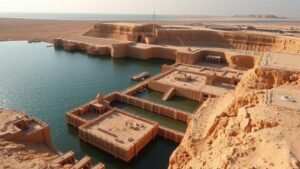How accidental discoveries have shaped the study of lost cities.
How Accidental Discoveries Have Shaped the Study of Lost Cities
The study of lost cities has long captivated historians, archaeologists, and the general public alike. While many advances in this field stem from systematic archaeology and planned expeditions, numerous significant findings have emerged from unplanned discoveries. These accidental revelations have not only reshaped our understanding of ancient civilizations but also inspired countless new inquiries into human history. This article explores several key instances of accidental discoveries that have significantly influenced the study of lost cities.
1. The Rediscovery of Pompeii
One of the most famous accidental discoveries occurred in 1748 when the buried ancient city of Pompeii was unearthed. Initially, the site was thought to be an unknown settlement, uncovered by workers digging for building materials. As excavations continued, archaeologists uncovered remarkably preserved buildings, frescoes, and artifacts dating back to A.D. 79, when the city was buried under volcanic ash from Mount Vesuvius.
This discovery dramatically shifted historical understanding of Roman life, providing concrete evidence of urban planning, architecture, and daily activities in a Roman city. By revealing details about social structure, art, and technology of the time, Pompeii became a critical case study in archaeology and increased public interest in ancient Roman history.
2. Incidental Findings in the Amazon Rainforest
In the 20th century, explorers and researchers accidentally stumbled upon remnants of lost cities deep within Brazils Amazon rainforest. Many of these finds were made while searching for resources or attempting to locate pathways for exploration. The most notable was the discovery of geoglyphs and earthworks that date back to as early as 1250 A.D., indicating the presence of sophisticated settlements, often referred to as geometric earthworks.
These accidental discoveries have led researchers to reconsider the historical narrative of the Amazon, traditionally viewed as a sparsely populated wilderness. It now appears that dense human settlements thrived in these areas, adapting the environment for agriculture and contributing to the intricate ecosystems we see today.
3. The Lost City of the Indus Valley Civilization
Another remarkable example is the accidental discovery of the Indus Valley Civilizations city of Harappa in present-day Pakistan in 1921. The city was unearthed during the railway construction process when workers stumbled upon ancient artifacts. Further investigations led to the discovery of a vast urban network, complete with sophisticated drainage systems, standardized weights, and evidence of advanced trade.
This serendipitous discovery enforced the need for proper archaeological methods and inspired dedicated excavations that revealed the complexity of this Bronze Age civilization. Today, archaeologists estimate that the Indus Valley Civilization was home to about 5 million people, making it one of the first urban cultures in the world.
4. The Maya Civilization: The Role of Aerial Surveys
In recent years, technological advancements have aided in the accidental discovery of lost cities, particularly in the jungles of Central America. A massive breakthrough came with the use of lidar (Light Detection and Ranging) technology in the mid-2010s. Researchers flying over the dense forest canopy unknowingly mapped out thousands of structures, revealing complexes that belonged to the ancient Maya civilization.
This technology led to astonishing findings, such as a previously unknown city in Guatemala that spanned an area of over 60 square miles, demonstrating the urban density and complexity of the Maya. Such discoveries have revolutionized the understanding of ancient civilizations’ scale and organization, showcasing the potential hidden beneath our world.
5. Impact of Accidental Discoveries on Cultural Legacy
Accidental discoveries of lost cities have had profound implications for cultural heritage. They have not only enriched historical narratives but also sparked ongoing debates regarding preservation, identity, and ethics in archaeology. For example, the excavation of sites often leads to conflicts over land use, indigenous rights, and modernization versus preservation.
Conclusion: The Importance of Serendipity in Archaeology
Accidental discoveries have proven essential in unearthing the stories of lost cities, illustrating that sometimes the pathways to understanding our past are unplanned. From the ancient streets of Pompeii to the intricate civilizations hidden in the Amazon, each find opens new chapters in human history and provides invaluable lessons for contemporary society.
As new technologies emerge, the potential for further accidental discoveries remains vast. Archaeologists should continue to embrace contingency and chance pursuits in the field while maintaining rigorous scientific methods. In doing so, they can unlock more secrets of our ancient past, enriching our understanding of human civilization.
To wrap up, the continued exploration and protection of these historical sites are vital for both preserving our heritage and inspiring future generations to engage with history.

